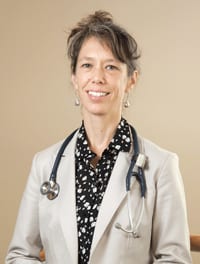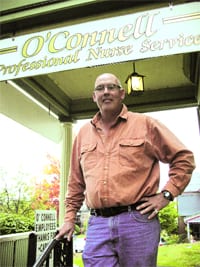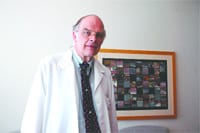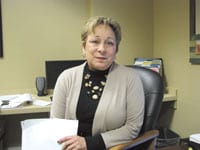Low-tech, High-touch – Geriatrics Holds the Key to More Holistic Care Across All Disciplines
Finding the best possible outcomes, focusing on the patient, and weighing risks against benefits.
These are three major aspects of geriatrics, a medical specialty that’s long flown under the radar as a relatively low-tech field, reserved for only the most fragile of seniors. The guidelines sound simple at first, but there’s much to be learned in today’s world from the holistic approach taken with the elderly.
Dr. Maura Brennan, chief of Geriatrics and the Post-Acute Medicine Division at Baystate Health, said geriatricians are quickly taking on a more visible role in healthcare as they share their knowledge base with other medical professionals.
“We’re facing a moment of enormous opportunity and potential transformation in the medical community for a variety of reasons, ranging from social pressures to generational expectations on the part of patients and the public, to the restrictions placed on how healthcare is provided and financed,” she said, noting that one of the hallmarks of geriatrics is its interdisciplinary approach. “We can be the leaders who teach that approach to others through program and professional development.”
Brennan explained that, from physicians to pharmacists; nurses to social workers; home-care professionals to transportation providers, the idea of caring for the whole patient is one that stretches across the entire geriatric landscape. The team approach has started to spread to other disciplines, she said, particularly in rehabilitative and palliative environments, but approaches that integrate full team-based care are still few and far between.
“Teams in general are important to medicine, but few specialties live and breathe it every day the way we do,” she said. “It’s the rare geriatric patient who only has one ailment. Generally, a person doesn’t need a geriatrician without a lot of things happening, so it takes multiple specialties and people to do it right.”
The Wisdom of Teams
Dr. Karen Prestwood, a geriatrician with Lenox Family Health, a Berkshire Health Systems physician practice, agreed with Brennan that the field is positioned to effect broader change in healthcare, in part due to a large faction of the population that’s not just aging, but more interested in aging well.
“There are more older adults, and they are healthier later in life than ever before, too,” she said. “So there is much more interest now in how to best take care of ourselves and our family members, and many more healthy people who are trying to best understand their own aging process.”
Prestwood explained that she gravitated toward the field because she enjoyed working in teams and wanted to pursue a specialty that allowed her to treat the whole person, as well as one that offered opportunities for constantly improved patient care.
“Almost every discipline would be better served with someone on board with a geriatrics background,” she said. “Working with the frailest and most complicated patients is where geriatricians make the most difference, so even when you’re thinking about long-term care, it makes sense that other providers need more geriatric training.”
Dr. Rachel Broudy, medical director of MercyLIFE, a suite of PACE (Program of All-inclusive Care for the Elderly) services, added that the health concerns of the elderly are changing, in part due to those longer life spans. People with heart disease, diabetes, or chronic mental illnesses live longer while managing their diseases, and new concerns can arise. For example, pain management can be tricky in the long-term, and the fastest-growing population affected by sexually transmitted diseases in the U.S. is currently the over-65 age group.
That can create a complex mix of treatments, prescriptions, and doctor visits, which require time and teamwork to sort out. What’s more, these added concerns are heaped on to the core concerns of all geriatricians for their patients surrounding nutrition, exercise, and socialization.
“We’re really focused on quality of life, improving function, and trying to understand the choices people make,” Broudy said. “It’s really holistic and very intimate. We need to intervene where we can, but not if it prolongs suffering, so we’re often pulling back from aggressive care toward end of life.
“Now, we’re also rethinking what end-of-life should look like,” he went on, “and society is beginning to accept that.”
In some ways, that new way of thinking translates to both patients and medical professionals who are more receptive to ideas rooted in geriatric care. In others, it translates to more concrete benefits, such as program funding, new technology, and workforce development. Just over a year after MercyLIFE launched, it completed a successful initial audit from the Centers for Medicare and Medicaid Services (CMS) and Massachusetts Medicaid.
Brennan added that Baystate Health recently secured $2.5 million in grant funding from the U.S. Health Resources and Services Administration to enhance the overall geriatric workforce through training and community programming. Baystate will also be further integrating geriatric and palliative care models into its primary-care practices over the next three years, and has begun fund-raising to make its pilot Acute Care of the Elderly (ACE) program permanent.
Some funding is geared toward technology, but with an eye toward improving doctor-patient communication, rather than replacing it. Prestwood said new technological interventions such as smartphone-based echocardiograms and remote stethoscopes that record heart rates from miles away will augment personal attention in ways never before available.
“I’m very excited about apps and other medical technology that will give us the ability to monitor someone remotely and get a better day-to-day view of how they’re doing,” she said. “I have no doubt that this will be possible; it’s just a matter of having these practices tested out and providing the training. Then, to be able to download blood sugars, blood pressures, or weight on a regular basis will give us one more way to prevent hospitalizations and get all of our patients’ data points more frequently.”
Constant Conversations
Indeed, while preventing injuries, hospitalizations, and emergency-department visits due to falls, osteoporosis, poly-pharmacy (too many or conflicting prescriptions), and other conditions among elders is the ultimate goal of geriatric medicine, the focus is always on the person, not the condition.
“We must always ask ourselves how much to intervene before we cause complications as opposed to benefits,” said Prestwood, to which Brennan added that, often, this comes down to having a conversation — or several — with the patient.
“It’s not always commonplace in medicine to have time to talk to people about what they want — we do this naturally in geriatrics,” she said. “The concern might be less about heart failure, for instance, and more about getting breathlessness under control so a patient can attend their daughter’s wedding. We may be low-tech, but we’re a ‘high-touch’ field — and that’s the beauty of it.”
Broudy echoed the sentiment that, in the field of geriatrics, not all decisions are clinical, but the clinical implications of the work are only extending in reach.
“We’re past the point of recommending big lifestyle changes, so we become very involved in our patients’ lives,” she said. “We’re really focused on quality of life, improving function, and making people feel better. It takes a lot of time and commitment, and the ability to gather around a common goal. But these are conversations that need to keep happening.”




